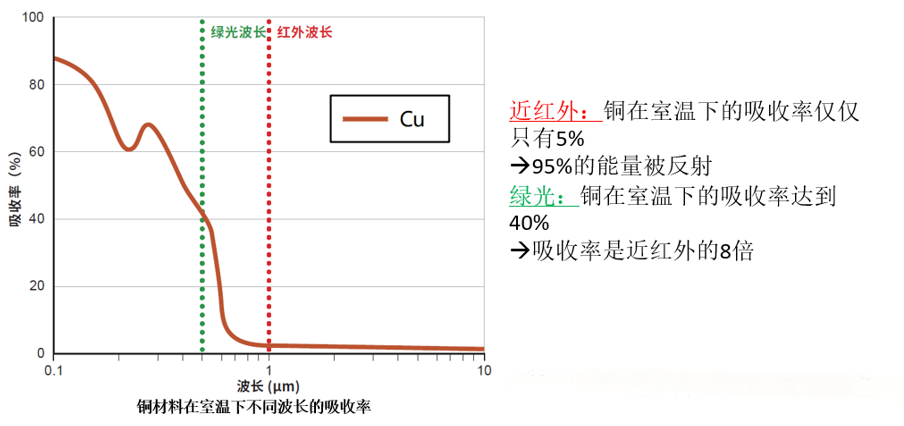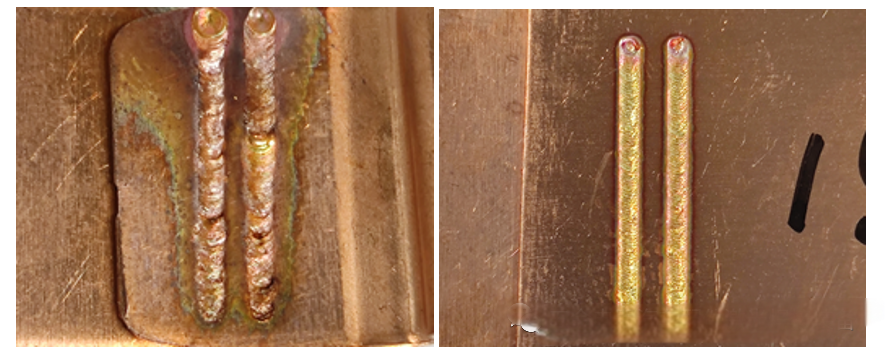 中
中
 400-9667-009
400-9667-009
 中
中
 400-9667-009
400-9667-009
Copper has excellent electrical conductivity, thermal conductivity, corrosion resistance and ductility, and good mechanical properties and processing properties. It is widely used in the fields of automobile manufacturing, chemical industry, ship communications and power systems. Laser welding, as an advanced welding technology, is widely used in the welding of copper and copper alloys. Since the copper surface has a very high reflectivity to traditional near-infrared laser light sources, it is very easy to produce spatter when high-power near-infrared laser is used to weld copper. After welding, many particles are attached to the surface of the material or workpiece, which can easily cause changes in surface roughness, scratches on the parent material, and contamination of the welding head protective lens. With the introduction of mature green laser technology into the market, this thorny problem has been effectively solved. Thanks to the high absorption rate of copper and copper alloys to green light wavelengths, green lasers have become the golden partner for copper welding, which can achieve extremely low spatter or even zero spatter welding.
1. Mechanism of splash generation
When the laser beam acts on the surface of the material, the metal melts to form a molten pool. Under the continuous heating of the laser, the liquid metal in the molten pool is heated and "boils", and finally the material absorbs heat and vaporizes. The steam changes the pressure inside the molten pool, bringing out the surrounding liquid metal and forming spatter.

2. Analysis of the reasons why near-infrared laser welding of copper easily produces spatter
At room temperature, the absorption rate of solid copper to near-infrared laser is only 5%. During welding, as the temperature of the copper material itself increases, the absorption rate of near-infrared laser also increases, increasing by about 20% near the melting point. Studies have shown that the absorption rate of liquid copper to near-infrared laser can be increased to about 40%, and even to about 60% after vaporization exceeding the boiling point. Therefore, as the absorption rate to near-infrared laser increases, the molten pool will be overheated, resulting in violent gasification of the material. In addition, the viscosity and surface tension of copper in the molten state are very low. Under the action of the intense steam pressure inside the molten pool, the liquid metal is easily squeezed out and splashes.

3. Advantages of green laser welding copper
At room temperature, copper's absorption rate for green laser is 8 times that of near-infrared laser. Compared with near-infrared laser, green laser welding can reduce overheating by increasing the initial absorption rate and reducing the difference in absorption rate after the material breaks through the melting point when the workpiece absorbs the same amount of heat. Based on the principle of the state change of the material itself, it can avoid the violent boiling of the molten pool and the spattering.

Green laser welding of copper has a stable and high energy coupling efficiency, which can achieve stable heat conduction welding. Based on the mechanism of heat conduction welding, there is no spatter in the welding process, achieving true zero-splash welding.

Green laser heat conduction welding of copper
At the same time, in the deep-penetration welding mode, green laser welding of copper can form a stable keyhole, effectively suppress the generation of spatter, and achieve almost spatter-free welding.

4. Comparison of green laser and near-infrared laser welding of copper
4.1 Pulse welding effect comparison

Green laser spot welding

Infrared laser spot welding
4.2 Comparison of continuous welding effects

Left: Infrared laser continuous welding, Right: Green laser continuous welding
Compared with traditional near-infrared laser welding of copper, the green laser has higher roundness and better consistency in the pulse mode; in the continuous welding mode, the weld surface is smoother and flatter, with no obvious spatter.
5. Some application scenarios of green laser welding

Left: heat sink, Right: battery adapter

Left: Auto parts, Right: Connectors